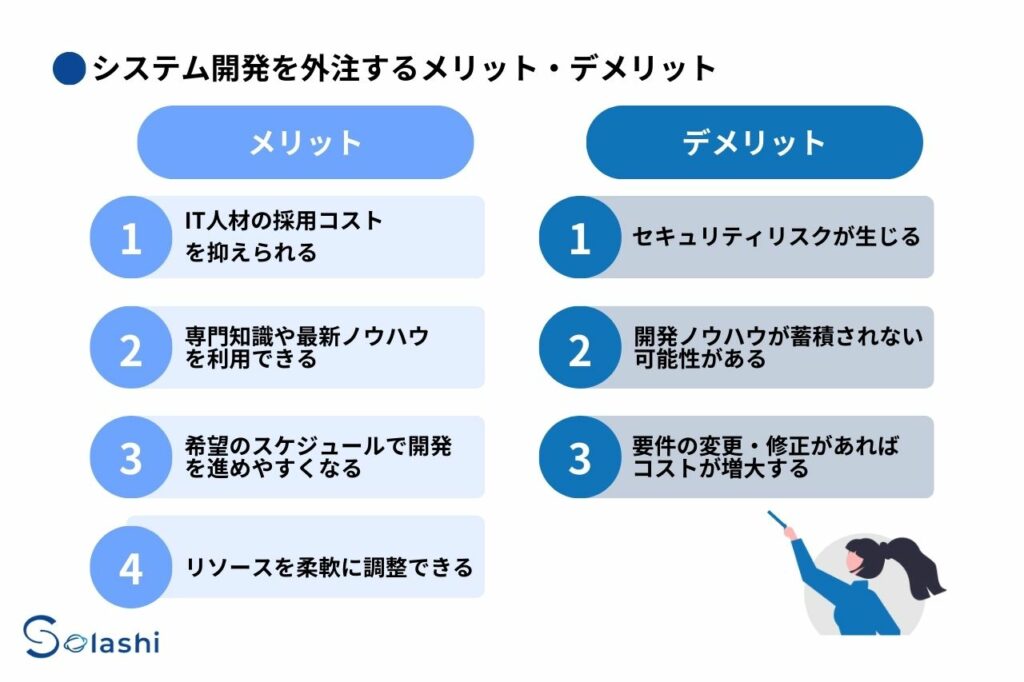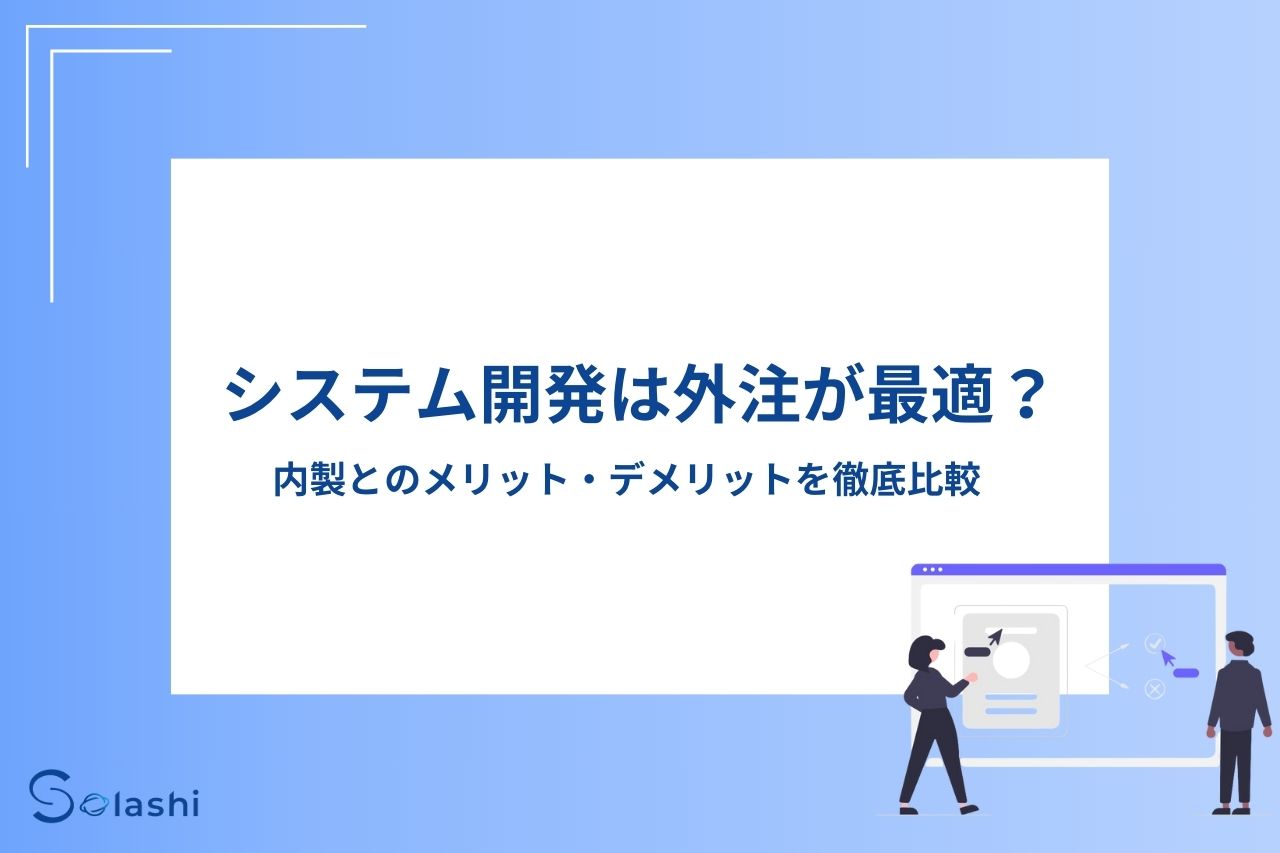If you’re facing challenges like “I don’t know how to develop a system” or “I’m stuck with in-house development,” why not consider outsourcing?
By outsourcing system development to external experts, you might be able to resolve the issues you’re currently facing.
In this article, Solashi Co., Ltd, a system development company, introduces the information you need to know when considering outsourcing system development.
We will explain the differences between outsourcing and in-house development, their respective workflows, cost averages, and the advantages and disadvantages of each approach.
We will also touch on tips to avoid failure when choosing a development company, so we hope that development managers will read until the end.

Akira Shimazoe
CEO of Solashi Japan LLC. Engaged in the development and operation of internal systems at Suntory. Founded Yper Inc., serving as CTO and CPO, contributing to product launch and growth.
Differences Between Outsourcing and In-House System Development
System development can be done through outsourcing or in-house development. Here, we will explain the outline, workflows, and costs of both approaches.
What is Outsourcing?
Outsourcing refers to the method of delegating system development to an external company. Traditionally, outsourcing was commonly done to SIers or IT vendors.
Recently, outsourcing methods that help reduce development costs have been gaining attention, such as:
- Offshore Development: Outsourcing system development to a company in another country
- Nearshore Development: Outsourcing system development to a company located in a regional city or nearby country
In nearshore development, companies are chosen in regions with lower labor and fixed costs compared to urban areas.
In contrast to offshore development, which reduces costs by outsourcing abroad, nearshore development reduces costs by outsourcing within the country, such as in regions like Kyushu, Okinawa, or Tohoku in Japan. Offshore development, for example, could involve outsourcing to countries like Vietnam, the Philippines, or India.
Related article: What is Offshore Development? Basic Knowledge, Benefits, and How to Avoid Failure
Outsourcing Workflow
Let’s take a look at the general workflow of outsourcing.
However, the content may vary depending on the company or project, so please consider this as an example for reference.
【Typical Outsourcing Workflow】
- Selection and Contracting of the Development Company: Meetings with various development companies based on the proposal request and selecting the contractor based on the provided estimates.
- Requirement Definition: Deciding on the system content, functions, performance, work volume, and schedule.
- Basic and Detailed Design: The development company creates design blueprints for the system’s functions.
- Development and Testing: The development company performs programming and tests the system to ensure there are no issues.
- Delivery and Operation: Receiving the deliverables and putting the system into operation.
- Maintenance and Support: Performing system fixes and improvements (whether this is covered by the contract depends on the specific terms).
If you are outsourcing system development, we strongly recommend monitoring the progress and status of the project in-house.
This will help you detect any discrepancies early on and prevent rework, as well as ensure developers are mindful of deadlines and encourage development progress according to schedule.
Avoid fully delegating the work to the development company, as this will ultimately help maintain quality and prevent delays in delivery.
Cost Averages for Outsourcing
The cost of outsourcing system development varies depending on the project. Prices range from a few thousand yen to over 10 million yen.
Most of the costs are attributed to labor. Since the cost varies depending on the skills of IT personnel, it’s important to consult with the development company if you have a clear budget for IT investment.
What is In-House Development?
In-house development refers to using your company’s own resources to carry out system development. In-house IT personnel handle everything from development tasks to operation and maintenance.
In some cases, you may seek support from subsidiary or affiliated companies, or utilize outsourcing or dispatching, such as SES (System Engineering Services).
The workflow for in-house development is listed below, but again, please treat this as just one example for reference.
| 【Typical In-House Development Workflow】 1. Planning and Proposal for System Development 2. Basic and Detailed Design 3. Development and Testing 4. Operation 5. Maintenance and Support |
The general process is similar to outsourcing, but in the case of in-house development, you must cover these tasks with your own internal resources.
In terms of costs, initial costs are typically higher. This is because you’ll need to invest in hardware, software, and the recruitment and training of IT personnel.
Advantages and Disadvantages of Outsourcing System Development

Outsourcing system development has both advantages and disadvantages. Here, we will introduce four advantages and three disadvantages.
Four Advantages of Outsourcing System Development
The advantages of outsourcing are as follows:
- You can reduce the cost of hiring IT personnel
- You can utilize specialized knowledge and the latest know-how
- You can more easily proceed with development according to your desired schedule
- You can adjust resources flexibly
Reduce the Cost of Hiring IT Personnel
By outsourcing development tasks, you no longer need to hire IT personnel. This allows you to reduce the costs and effort involved in hiring.
In November 2023, there were 7,003 job seekers in IT technology-related fields in Tokyo, with 22,002 job openings.
(Source: Job Openings by Occupation and Job Seekers (Regular Employment) November 2023 | Tokyo Hello Work)
As shown in the data above, there is a shortage of IT personnel, and hiring them can incur a significant burden.
However, with outsourcing, where the development company handles recruitment, this concern is alleviated. You can secure the necessary development resources without hiring new staff in-house, thus avoiding recruitment costs.
Utilize Specialized Knowledge and Latest Know-How
By outsourcing tasks to external IT personnel, you can take advantage of the specialized knowledge and cutting-edge technologies of the contracted company. Specific details include the following:
- Recently developed technologies
- Trending development methods
- Utilization of frameworks
- Optimal implementation methods
- Accurate procedures for development progress
- How to handle issues and problems
Companies without prior development experience can also take on high-level development challenges by leveraging the expertise of professionals.
Easier to Progress Development on Desired Schedule
One of the advantages of outsourcing is that it becomes easier to progress development according to the planned schedule. This is because the duration required for development is defined at the time of the contract.
Typically, the development company manages the schedule according to the deadline, but it is important for the client to stay proactive in confirming the progress.
By monitoring progress and keeping in touch regularly, both parties can proceed with development in a reassuring manner.
Flexible Resource Adjustment
Outsourcing allows for easy adjustment of the necessary human resources at any given time. The number of IT personnel and team structure can be adjusted as needed to move the project forward.
In in-house development, there is a risk of underutilizing hired IT personnel during periods when there is no ongoing development work.
Additionally, personnel costs, such as salaries, bonuses, and social insurance, continue to be fixed costs every month, which can be a disadvantage.
With outsourcing, you can adjust resources flexibly.
Three Disadvantages of Outsourcing System Development
Next, let’s look at three disadvantages of outsourcing.
- Security risks may arise
- Development know-how may not be accumulated
- Changes or revisions to requirements may increase costs
Security Risks May Arise
When outsourcing development tasks, the risk of information leakage may increase. This is because, depending on the project, it may be necessary to provide the development company with sensitive data such as customer information.
If security-related issues arise, it could harm the company’s reputation and negatively affect future business.
To mitigate these risks, we recommend signing a non-disclosure agreement (NDA) that outlines the handling and retention of sensitive information.
Development Know-How May Not Be Accumulated
Due to the limited opportunities for in-house personnel to be directly involved in development tasks, there is a drawback in that development know-how may not accumulate internally. This is because, in outsourcing, the development company takes the lead in progressing the project.
If a company without know-how tries to move forward with the next project, they may have to rely on outsourcing again. For companies aiming to build in-house capabilities in the future, outsourcing may not be the best option.
However, in some cases, outsourcing can involve collaborating with the development company to define requirements and designs, which could increase opportunities to acquire development knowledge and know-how. It’s worth discussing with the development company for such opportunities.
Changes or Revisions in Requirements Can Increase Costs
In some cases, costs can escalate, which is one of the disadvantages.
If changes or revisions in requirements occur, there may be additional charges for parts not included in the original estimate.
Communication errors with external parties can lead to misunderstandings and require rework of the tasks.
If the requirements definition is unclear or not well-defined during the early stages, revisions may be needed during development, leading to higher costs than originally planned.
Advantages and Disadvantages of In-House System Development
There are also advantages and disadvantages when choosing to develop a system in-house. To determine which option, in-house or outsourcing, is more effective for your company, it’s important to understand both sides.
Advantages of In-House System Development
The main advantages of in-house development are as follows:
- It’s easier to develop the system your company wants
- It promotes skill improvement for employees
First, by choosing in-house development, it becomes easier to create the ideal system your company desires. Compared to outsourcing, where communication with a development company is required, in-house development allows for flexible and detailed changes to specifications.
Depending on the nature of the system, there may be requests for additional features, changes, or deletions during development.
Since the developers are part of the same company, these changes can be accommodated without incurring additional costs. They can develop according to the project’s ideal vision while making adjustments as needed.
Having your own employees take on development tasks also greatly improves overall IT skills.
【Overall IT Skills】
- Programming skills
- Management skills
- Specialized knowledge & latest know-how
As development know-how accumulates within the company, it becomes possible to complete high-level systems in-house in the future.
Disadvantages of In-House System Development
The major disadvantages of in-house development are listed below:
- Resource management can be difficult
- It’s challenging to acquire IT personnel suited for the company
- There is a risk of decreasing system quality
- Cost calculations can become complicated
After a project is completed, there may be no tasks for IT personnel to handle, and you may struggle with resource management.
Furthermore, if an IT specialist leaves the company after some time, improving or modifying the system may become difficult.
In addition to this, it is not always guaranteed that your company will secure the IT personnel best suited for the job. If the internal team does not understand what kind of personnel are needed in terms of skills and career, the project may not progress smoothly.
Depending on the IT personnel’s skills, outsourcing may be able to build a higher-quality system.
Alternatively, outsourcing may also have the disadvantage of being difficult to grasp the total cost since there is less need to precisely calculate the man-hours required.
Should You Choose Outsourcing or In-House Development for System Development?
Depending on your company’s circumstances, you should decide whether to choose outsourcing or in-house development. The main points to consider are as follows:
-
- Current in-house resource situation
-
- Project scale
-
- Objectives you want to prioritize
If your company already has IT personnel with specialized knowledge and sufficient resources, in-house development is a good option.
This is also true if you have some flexibility in terms of time and want to gradually expand the scale, or if you want to prioritize security measures.
On the other hand, outsourcing is effective when resources are lacking, you want to start a large project immediately, or you want to focus on expertise.
If You Lack Development Resources, Outsourcing Is Recommended
Companies facing the following challenges are especially recommended to choose outsourcing:
By choosing outsourcing, you can supplement the lack of resources for various development tasks.
-
- Insufficient personnel or time availability
-
- Lack of direction or management skills
-
- No IT personnel with specialized knowledge
-
- No personnel with specific development know-how
-
- Unable to handle advanced technologies
The system development company “Solashi Co., Ltd” supports system development tailored to customer needs.
From technology selection to design, development, infrastructure setup, and demo screen production, our engineers handle the entire process.
If you lack development experience and don’t have personnel to manage the project, it’s not a problem. Our PMs, with experience in business launches, will support management tasks.
If you are struggling with resource shortages in AI, OCR, Web, blockchain, or app development, feel free to contact us for assistance.
Three Tips to Avoid Failure When Choosing an Outsourcing Partner for System Development
Depending on the outsourcing partner, there is a risk that the system may not meet expectations or that costs may spiral out of control.
To avoid such risks, here are three key tips for selecting an outsourcing partner.
Get Estimates from Multiple Development Companies
Don’t limit yourself to just one development company; get estimates from multiple companies. By comparing the prices offered by each, you can get a sense of the overall price range.
When making comparisons, it’s important not just to look at the price, but also to check the technical capabilities of each company. No matter how low the price is, it won’t be meaningful if the desired product can’t be completed.
By comparing estimates with a broad perspective, select the best development company for your project.
Check for Communication Issues
Choose a development company with which you can communicate smoothly with the person in charge.
Because it becomes easier to convey your company’s requirements to the person in charge, it will ultimately lead to successful project outcomes. If communication breaks down, there is a risk that a product that differs from expectations will be delivered.
If you are considering offshore development, be sure to pay attention to the following points:
-
- Which language will be used for communication?
-
- Is the Japanese language proficiency high?
-
- Which communication tools will be used?
Related article: “How to Choose an Offshore Development Company? 4 Steps and Tips to Avoid Failures“
Select a Development Company with Extensive Similar Experience
It is also important to choose a development company that has experience in projects similar to the one you are considering.
If they have similar cases in terms of system types, scale, and industry, your project will likely progress smoothly, as they can leverage their prior experience.
Different companies have their own areas of expertise. It is recommended to verify the achievements of the companies you are interested in. When researching, check their website and official materials.
If you want to obtain information about features and achievements not listed in these materials, sending an RFI (Request for Information) is also effective.
An RFI is a document requesting a development company to provide basic information, achievements, technologies, and products. The documents provided will help in narrowing down potential outsourcing partners.
Outsource Your System Development to Solashi
If you are considering outsourcing system development, please contact the offshore development company “Solashi Co., Ltd”.
Vietnam, as an offshore development country, has the following characteristics:
-
- Easy to reduce costs
-
- High IT level and expect to secure skilled engineers
-
- Only a 2-hour time difference from Japan, making communication between the two countries easier
As a reference, here are the estimated development costs:
▼ Outsourcing to a Japanese Development Company
Development period: 3 months
Number of employees: 2 SEs
Cost: Approximately 5.4 million yen
▼ “Solashi Co., Ltd” Lab-type Development
Development period: 3 months
Number of employees: 1 lead engineer, 1 BeSE, 2 SEs, 1 QA with senior support
Cost: Approximately 4.04 million yen
(Reference: Extracted from our company profile)
This is just an example, but by outsourcing to us, you can reduce costs compared to domestic companies while still maintaining a high-quality team and excellent development.
We have a Japanese PM with experience in launching businesses in Japan who will support the project. All emails from local engineers are also handled in Japan, which is one of our strengths.
If you are looking for low-cost, high-quality system development, feel free to contact us for more information.
Akira Shimazoe Representative of Solashi Japan LLC. Born in April 1989 in Fukuoka Prefecture. Graduated from the Graduate School of Information and Mathematical Sciences at Osaka Prefecture University. Joined Suntory System Technology Co., Ltd., an IT subsidiary of Suntory Holdings, in 2014. Broadly responsible for the development, operation, and implementation of vending machine delivery management, efficiency improvements, and sales management systems. Founded Yper Inc. in 2017, serving as CTO and CPO. Contributed to the launch and growth of the app-linked delivery bag "OKIPPA." Selected for Toyo Keizai's prestigious "Amazing Venture 100" and Forbes' "Forbes 30 Under 30 Asia 2019."

 日本語
日本語

